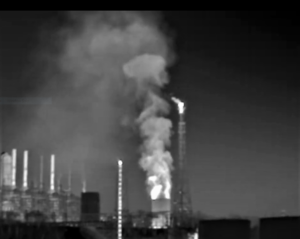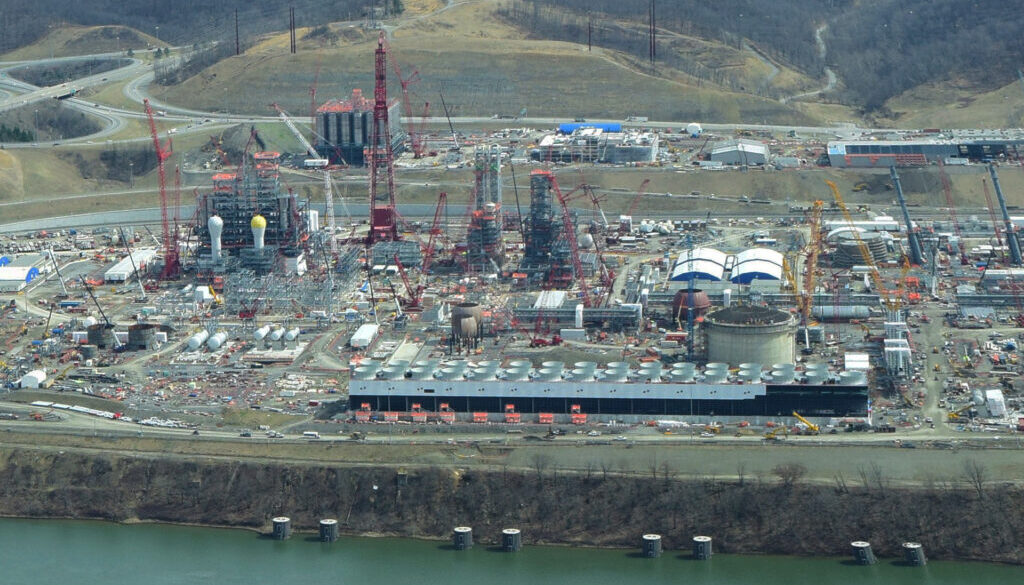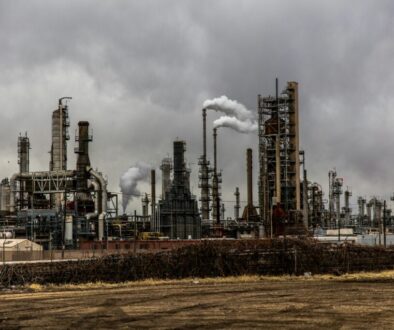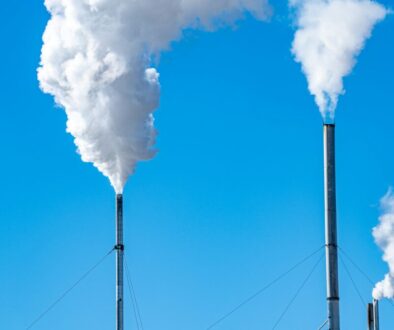Outrage over fresh chemical leak at Shell plastics plant
By Dana Drugmand
When Shell Chemical Appalachia announced the start of a massive plastics manufacturing facility last November in western Pennsylvania, the subsidiary of oil major Shell described it as “world-class,” and touted the company’s “strong and innovative safety focus.”
But now, just six months later, the plant has been the site of multiple malfunctions, including the leakage of benzene, a known carcinogen, along with other pollutants last month. The events come with putrid chemical odors and have area residents fearing for their health and calling on state officials to shut the plant down.
“We’re being told everything is okay, everything is safe, and it’s not,” said Hilary Flint, a cancer survivor who said she worries daily about how the malfunctions at the Shell plant may be affecting her health. Though she lives several miles away, she often spends time visiting her partner in Monaca, the community neighboring the Shell plant. Flint said both she and her partner contracted respiratory illnesses the week of the Shell plant’s chemical leak.

On Tuesday, the environmental advocacy group Earthworks shared a video the group said showed “a major pollution event” that occurred April 13-14, dates that Shell air monitors recorded benzene levels up to 110 micrograms per cubic meter. The minimal risk level for benzene exposure is set at 29 micrograms per cubic meter, set by the US Department of Health and Human Services’ Agency for Toxic Substances and Disease Registry. The World Health Organization says benzene exposure is a “major public health concern” and that “no safe level of exposure can be recommended.”
For Shell, a benzene level above nine micrograms per cubic meter is supposed to trigger an investigation, under the terms of an agreement between Shell and environmental groups.
A key issue is Shell’s “ground flare pollution control,” a process designed to burn up invisible harmful hydrocarbons produced through plant operations so they don’t contaminate the air. While Shell has assured the community its flares successfully destroy up to 99.55% of emissions, Earthworks and other groups critical of Shell claim air monitoring proves the flaring operations are not working.
“Shell is releasing harmful pollutants and exceeding multiple pollution limits,” Anais Peterson, Earthworks petrochemical organizer, said in a statement Tuesday. “For almost six months Shell has been polluting Beaver County and the surrounding areas with no repercussions.”
Shell did not respond to a request for comment. In its air monitoring report for early April, however, the company stated that on April 11, the plant was “de-inventorying in preparation for repair work,” when “excess free hydrocarbon was sent to the biotreaters from one of the wastewater tanks due to a level issue.” The company said the “cause is understood and has been addressed and solutions are being implemented.”
Multiple malfunctions
Shell’s facility, which it calls Shell Polymers Monaca, is situated on 386 acres on the banks of the Ohio River in Beaver County, Pennsylvania, approximately 30 miles northwest of Pittsburgh.
It is the first major plastics production plant in the northeastern US and the biggest petrochemical plant outside of the US Gulf Coast. Designed to turn raw materials derived from oil and gas into a plastics component called polyethylene, the operation is emblematic of an ongoing buildout of petrochemical plants in oil- and gas-rich areas as major petroleum producers such as Shell eye plastics as a key profit stream.
The facility experienced numerous equipment problems last year as it prepared to come online, with problems continuing after the operational startup in November. The company has submitted 39 malfunction reports to state regulators since January 2022, including over a dozen since the facility came online.
State regulators at the Pennsylvania Department of Environmental Protection (DEP) have issued 14 citations, called Notices of Violations, to Shell since April 2022, and 11 of those have been over air permit violations. The plant continuously emits air pollutants such as volatile organic compounds and nitrogen oxides in excess of its permit levels.
There have been multiple large flaring events in recent months including an emergency flaring episode on February 13 that lasted several hours and featured visible plumes of black smoke and a fiery orange flare. A month later the plant had another major flaring event lasting almost three hours.
“It’s clear something is wrong with this plant,” said Matt Mehalik, executive director of Breathe Project, an environmental and public health collaborative advocating for improved air quality. He said it is particularly egregious that the operations received $1.65 billion in tax breaks.
Area residents and community advocates say the response to the chemical leak from state and local officials in some ways echoes that of some government officials in the wake of the East Palestine, Ohio train derailment just 20 miles away. Government officials have downplayed residents’ concerns for their health, they say.
“The government and the companies tell you it’s safe, but that’s not how you feel,” Flint said. “Between Shell and the Norfolk Southern train derailment, I think that the [Pennsylvania] DEP and the EPA need to be held liable for how they are putting these communities at risk.”
DEP spokesperson Lauren Camarda declined to comment.
(Featured image is of the Shell plant in “BeaverCounty_PA” by Ted Auch, FracTracker Alliance is licensed under CC BY-NC-ND 2.0)
 EWG
EWG



May 6, 2023 @ 5:18 pm
Your article “Outrage over fresh chemical leak at Shell plastics plant” should help residents in this area of Beaver County and downwind in Pittsburgh understand the risks involved in the Shell cracker plant. I would add that this cracker plant received a significant amount of funding from Pennsylvania and its subsidiaries. Without this underwriting I doubt the cracker plant would be an economically viable producer of plastic waste.
Your article led me to thinking about the 6 years I worked in the R&D facility as a materials analyst at the St. Joe Mineral/Zinc Corporation of America zinc smelter that was located on the site of the cracker plant. Your article mostly concerns people living around the cracker.
I believe it would also benefit the workers at the cracker and their families if you would investigate and expose the level of mercury (atomic symbol Hg) exposure. Exposure to Hg is a very toxic for mammals. I have heard that some workers at the cracker who were tasked with excavation of the topsoil for various purposes became ill from Hg exposure.
The cracker was built on the site of the St. Joe Minerals/Zinc Corporation of America zinc smelter. This facility was built around 1930. It processed zinc ore, zinc sulfide – ZnS, for about 70 years. The ore was mined in St. Lawrence County, NY at the Balmat-Edwards mine complex. The average Hg content of the ore was 8%. This would produce around 8,000 tons of Hg per annum.
A majority of the Hg was recovered as pure Hg liquid. However a significant amount of Hg was emitted from the high stacks that exhausted the gases from the smelting of the ore concentrate. This aerosol Hg was very dense so it traveled a few hundred yards and dropped on the hillside across Route 18 east of the Ohio River.
When I started working at the St. Minerals R&D center as a microscopist, I rented an apartment less than a mile from smelter, known colloquially as the Red Rooster. It was located on the east side of Route 18 on the hill where the Hg droplets fell out of the offgas. At some point I put on my hiking boots and walked the hillside, not yet aware about the Hg emissions from the smelter. I did know what liquid Hg looked like. I was amazed when I stepped on the stunted weedy undergrowth dotted with dead trees when the shiny liquid Hg would pool around my boots.
Now when Shell prepared the old St. Joe Minerals site it stated that the contaminated site along the Ohio River would be covered with a thick layer of soil. I can’t recall if it was 12 or 20 feet. But it was a respectable cover.
Now here’s the punchline: Shell covered the smelter site by bulldozing that Hg saturated hillside down across Route 18. They then covered that thick layer of Hg saturated soil with another layer of clay. I have no idea how thick that clay is. But it made perfect sense when I heard that workers doing excavation got sick from Hg exposure.
For the Balmat Hg content see “Geochemistry of sphalerite concentrates from the Balmat-Edwards Zinc Ores, St. Lawrence County, New York, Lehigh University, 1-1-1979.